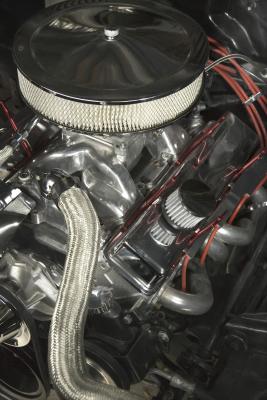
Cast-aluminum intake manifolds have a lot going for them in terms of function and production, but they do have at least one major flaw. Like engine blocks, aluminum manifolds are investment cast by pouring liquid aluminum onto a mold made of sand. This process leaves the manifold's surface slightly rough to the touch and likely to absorb fluids such as oil and antifreeze. Combined with the powder-like oxidation that forms on the aluminum's surface, and cracks that may form during use, these kinds of stains and contaminants can visually and functionally ruin an otherwise-fine intake manifold.
Drop the manifold into a shallow container -- a large backing pan usually works -- and fill it with a mixture of 80 percent water and 20 percent dish detergent. Mix it well, and submerge the manifold in the mixture overnight. You can speed this process and deepen the stain removal by heating the water to about 150 degrees Fahrenheit; just high enough that the soap doesn't foam and boil over.
Remove the manifold and scrub it with a paintbrush and more soap. The detergent should have softened and lifted most of the oil out, so you may only need to give it a slight scrubbing. Rinse the manifold and dry it with compressed air. Repeat this process with specialized aluminum cleaner; some manufacturers may make specific product recommendations, but any aluminum wheel cleaner works. Allow the manifold to sit for as long as you can, then remove it, clean it with a paintbrush and dry it with compressed air.
Tape over the mating surfaces on the manifold -- the flat parts where it bolts to the cylinder head and carburetor or throttle body. Apply a double layer of tape, then trim away the excess with a razor. You only want the mating surfaces and bolt holes covered; leave the ports and internal passages exposed so you can sandblast and clean them.
Sandblast the manifold with 200-grit sand to remove any deeply imbedded stains and grime; avoid the duct-taped mating surfaces wherever possible. You may stop here if you like, but the 200-grit may leave a rougher finish than you prefer. If you like, you may go back over it with finer 400-grit or 500-grit sand; that's slightly smaller than the sand used in the original casting, which should leave the manifold with a nice factory finish.
Remove the duct tape and use the flat sanding board and 1000-grit sandpaper on the mating surfaces. Use a sanding board at least 18 inches long, and keep an eye out for strange patterns appearing on the surface as you sand. Patterns on the surface indicate a wavy mating surface with low spots that may not seal properly. If the patterns are very distinct or you can't get the surface flat with sandpaper, you may need to take the manifold to a machine shop to have it milled.
Thoroughly wash the manifold to remove any cleaner or sand inside; this step is crucial for keeping sand out of your engine and cooling system, so take your time. Once you have the manifold clean and dry, spray it with a couple of light coats of clear-coat paint designed for intake manifolds or engine blocks. Don't use a standard clear; it's not designed for high temperatures, and quickly will burn and turn yellow or brown.